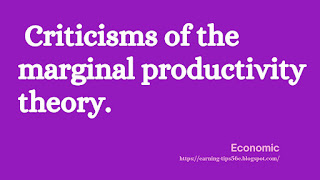Criticisms of the marginal productivity theory.

Criticisms of the marginal productivity theory.

The Marginal Productivity Theory of distribution can be criticised from different view points.
1. First: The main defect of this theory is that it is based on some unrealistic assumptions. For example , it is assumed in this theory that each factors of production is perfectly divisible. If any factors of production is indivisible, then the marginal productivity of that factors of production cannot be calculated.
2. Second: In this theory, it is assumed that there exists substitutability among different factors of production. But this assumptions is not true in many productions processes. Sometimes it is found that different factors have to be employed in a fixed proportion. In that case, the marginal productivity of any factors of production cannot be calculated.
3. Third: In the marginal productivity theory, it is assumed that all units of a factors of production are homogeneous. This assumption is also not realistic. All units of factors of production are not always homogeneous. For example, we cannot assume that all units of labour are homogeneous. There are differences in education, experience, ability, etc. , among different units of labour. Hence, it is not realistic to assume that all units of labour are homogeneous.
4. Fourth: In this theory, it is assumed that there exists perfect competition in the product market and also in the factor market. Thus this theory is applicable only under conditions of perfect competition. If the perfect competition is not present either in the commodity market or in the factor market, then this theory will not be applicable.
5. Fifth: The marginal productivity theory considers only the demand side of any factors of production. It does not consider the supply side. The demand curve of any factors of production is determined from the marginal productivity curve of a factor of production. In fact, the marginal productivity curve of a factor of production is its demand curve. The supply of the factor of production is assumed to be perfectly elastic. In other words, the supply curve of the factor of production is assumed to be a horizontal straight line. But this is not realistic. Like the supply curve of other commodities, the supply curve of any factor of production should also be upward rising. But this has not been considered in the marginal productivity theory.
5. sixth: According to the marginal productivity theory , if each factors of production is paid according to its marginal productivity, then total product will be completely exhausted. But this will be true only under conditions of constant returns to scale. If the production process is subject to increasing or descreasing return to scale, then the total products will not be exhausted.
Due to the above limitations, the marginal productivity theory cannot be taken as a satisfactory theory of factor pricing. For this reason, modern economists have considered the demand supply theory for determing factor prices. According to the demand supply theory, the price of any factor of production is determined by the demand for and supply of that factor of production. The demand for the factor of production is determined on the basis of marginal productivity of that factor of production. But the supply of the factor of production does not depend on marginal productivity. Hence, the marginal productivity theory considers only the demand side. It does not consider the supply side. For this reason, this theory is incomplete.








0 Comments